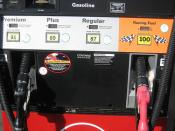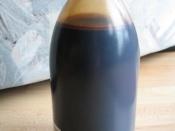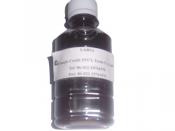Most fuels are hydrocarbons, that is, chemical compounds made up only of hydrogen and carbon. Hydrocarbons are part of the larger family of organic compounds. Any compound that contains a carbon atom is referred to as an organic compound. The reason is that carbon compounds were first identified in plants and animals, and ÃÂorganicÃÂ means ÃÂrelated to living things.ÃÂ Organic compounds are plentiful. More than 90 percent of all known compounds contain carbon.
A molecular formula indicates the number of atoms of each element in one molecule of a compound. For example the molecular formula for methane is CH4. A molecule of methane has one atom of carbon (C) and four atoms of hydrogen (H4). The molecular formula doesnÃÂt tell how the atoms in a compound are arranged. A structural formula will tell you approximately how the atoms are arranged.
Fig3 CH4 representationAt the moment the most important fuels as gasoline and diesel became from petroleum or crude oil.
The crude oil was formed over millions of years from the remains of decomposed living organisms and is composed basically from hydrocarbons.
Gasoline is made up from primarily Paraffins and aromatics, and can be improved in terms of quality with the addition organic components.
ThatÃÂs why we find different kinds of gasoline in the service stations. Generally the premium gasoline have an higher aromatics content than the normal gasoline as oxygen is also added to make the fuel work with higher compression ratio engines.
A pure chain of paraffin (C5H12) has a very good ignition performance but a very low knock resistance, thatÃÂs why iso-paraffins, and benzene is added on the gasoline, these two components improve the knock resistance.
The knock resistance is ÃÂmeasuredÃÂ by the octane level, gasoline with bigger knock resistance have bigger octane rates, these octane...


